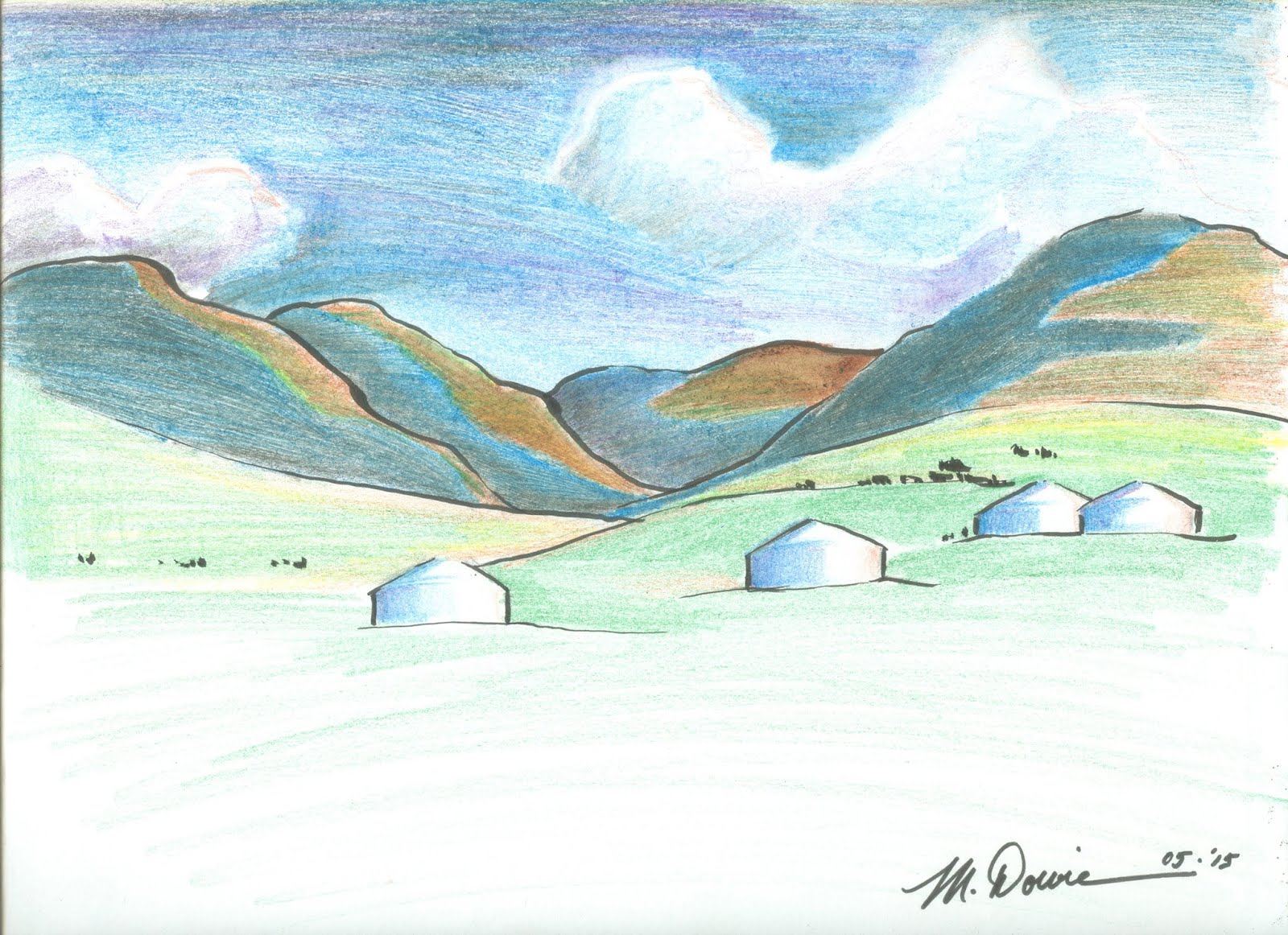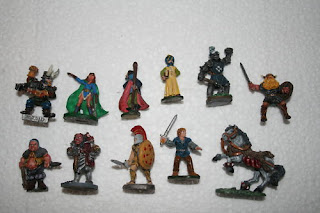
Fine. I'm in. Lets see what alphabetically related D&D musings I can come up with over the course of April.
This is a blog about "Old School" RPGs and the OSR movement in gaming. I also write about other stuff, like miniatures for wargames and RPGs, wargaming, my family, etc.






























Using the new (to me) concept of 1d8 + 1d12 tables-
2- Really Bad
3-4 Bad
5-7 Slightly Bad
8-14 Nothing
15-17 Slightly Good
18-19 Good
20- Awesome!
This assumes that the drinking/bathing character is of the same alignment as the pool or spring, or at least not of an oppositional alignment. For character's of opposing alignments reverse the results so Really Good becomes Really Bad, etc.
Then I move on to a subtable for each result,generally 1d6-
Really Bad
1- Sacrifice: Character is compelled to kill the rest of the party as a sacrifice to the pool, if alone will kill self.
2- Struck Dead: Save vs Death Magic or die!
3- Level Drain: 1 level of experience gone!
4- Stat Loss: Save vs Spells or lose 1d4 Points from your Prime Requisite.
5- Hit Point Loss: Save vs. Death Magic or lose 1d6 HP permanently.
6- Gate Opens: A random extra-planar creature of appropriate alignment to the pool appears to lay the smack down on your ass.
Bad
1- Comatose: Save vs Spells or become comatose for 2d6 days.
2- Change Alignment: The character's Alignment changes to match the pool, Remove Curse to reverse.
3- Disease- Save vs. Spells or be afflicted with a magical disease (Mummy Rot is my favorite)
4- Stat Loss: Save vs. Spells or lose 1d4 points from a randomly determined stat.
5- Damage: Take 1d10 points of damage, Save vs. Spells for half.
6- Curse: As a Cursed Scroll (DMG 121).
Slightly Bad
1- Body Odor: The character's body odor becomes much stronger and very distinctive, for 2d6 days random encounters occur twice as frequently as a result.
2- Body Odor II: For the next 1d6 days the character has Carrion Stench like a Ghast (MM 43).
3- Blindness: As the 3rd level Cleric spell.(PH 46)
4- Disease: As the 3rd level Cleric spell (PH 46)
5- Flatulence!: The next time the character enters battle a Stinking Cloud spell (PH 72) is emitted centered on the character.
6- Mute: Character becomes unable to speak for 1d6 days.
Slightly Good
1- Infravision: Character gains 60' infravision for 1d6 days, if they already have infravision 60' is added to the range.
2- Lucky: The character re-rolls next failed saving throw.
3- Cured: Cures blindness or non-magical disease afflicting character.
4- Blessed: Character is affected by a Bless spell (PH 43) during their next combat.
5- Protected: Character is recipient of Protection from Evil spell (PH 44) during their next combat.
6- Suave: Character makes next reaction roll as if their Charisma were 18.
Good
1- Healthy as a horse: Character gains 1d10 HP until they are lost as damage.
2- Remove Curse: The next time it would be appropriate the character gains the benefits of a Remove Curse spell (PH 47) as if cast by a 12th level Cleric.
3- Disease Immunity: The Next time it would be appropriate the character gains the benefits of a Cure Disease spell (PH 46).
4- Stat Gain: A random stat increases by 1d4 points.
5- Real lucky: Character automatically makes next saving throw.
6- Aware: Character cannot be surprised for the next 1d4 days.
Awesome!
Regardless of die roll alignment changes to match pool.
1- Hale and Hearty: Character gains 1d10 HP to their permanent total.
2- Prime Stat Gain: Character adds 1d4 points to their prime requisite.
3- What's That There?: A random beneficial magic item floats to the surface for the character.
4- Are You Experienced?: Character gains (1d4x100)x level experience points from a religious vision.
5- Infravision II: The character gains 60' infravision permanantly.
6- Proof Against Disease: Character gains disease immunity as a Paladin (PH 22) unless alignment changes.
When I moved to a more wilderness based style of play; where even if you found a dungeon it was likely to be a ruined temple's crypts or catacombs beneath a ruined city or the sewage system of a living city, I lost a lot of the old mega-dungeon tropes and the magic pool type thing was also lost. I ditched a lot of the mega-dungeon tropes in search of verisimilitude too.
I have been thinking about this because I have recently been considering the way I randomly add places to an encounter table when I make them for an area. A typical encounter table in my Garnia campaign for, say, a wooded area might have a goblin patrol, a wild boar, a bear, a human warband hunting goblins, an abandoned wood-cutter's hut, a shrine to a random god, change in weather, etc. Some of those will only be encountered once, thereafter treated as no result. The shrine gets me thinking about those pools, particularly in Garnia with it's Celtic veneer, because pools and springs were often sacred sites to the Celts.
I have to admit I was also inspired by my recent rediscovery of my Talisman game. In Talisman there are several waters that give different, although fixed, effects; one each for Life, Strength and Craft. Of course those are only good for a fixed number of points each too, which differs from most D&D magic pools as I recall.
The Romans even took advantage of the sacred significance and reputed healing powers of Celtic sacred pools, most notably at Aquae Solis (Bath, England); mind you they were pretty fond of baths to start with. Since I already have non-recurring sacred sites popping up in my random encounters in the form of shrines, I figure maybe it might be a good idea to bring back the pools and springs.










 I have had kumiss and it's not bad, Matt S. (Steppe Warrior ID: Sengum) made some for the first Steppe Warrior gathering back in December of 1997.
I have had kumiss and it's not bad, Matt S. (Steppe Warrior ID: Sengum) made some for the first Steppe Warrior gathering back in December of 1997. My wife has made buuz; it's pretty good, particularly if you like lamb or mutton.
My wife has made buuz; it's pretty good, particularly if you like lamb or mutton. I have seen some in real life, at SCA events.
I have seen some in real life, at SCA events.
 The expert book could have been in better shape, and I'll probably keep looking for a better one, but the price was good. My original copy was a casualty of me going to college and my mom deciding to "clean my room"*.
The expert book could have been in better shape, and I'll probably keep looking for a better one, but the price was good. My original copy was a casualty of me going to college and my mom deciding to "clean my room"*.


